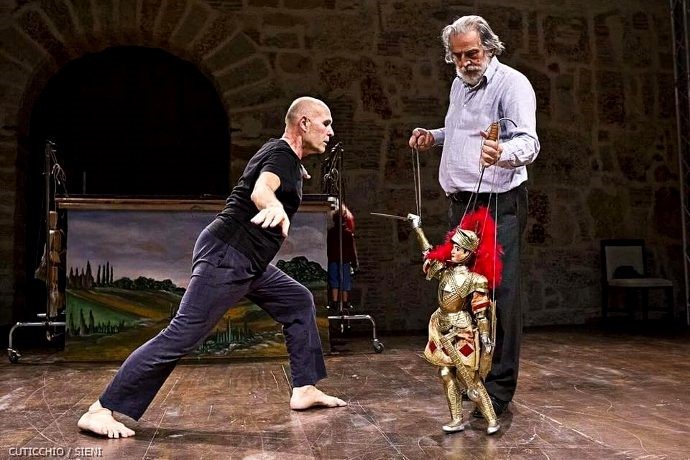
In the endless ideological battle between expressing yourself or depersonalizing actors and performers on stage, dance offers every kind of possibilities from the dawn of modernity to the consequences on the new millenium. Virgilio Sieni is a good example. Experienced “body artist” from the early 1980’s, director of the Venice’s Dance Biennale (from 2013 to 2016) and lof Cango National Choreographic Center in Florence. About Sieni’s experience a book has just been published by Vito di Bernardi, Eastern dance-theatre specialist and professor at La Sapienza University in Rome. It is entitled Ossatura (Strcture), Bulzoni Editore, and includes experiences and voices of the Italian choreographer and contemporaneity champion, along with the story of Mimmo Cuticchio, master puppeteer and acto, who keeps this folklore tradition. Both actors have also elaborated in common Nudità.
Sieni (1958) and Cuticchio (1948), the performer of the Sicilian Opera dei Pupi, simultaneously deal with pure movement in the terrain of human body and puppet’s one, in the style of XXth century innovation’s theorists Kleist, Schlemmer and Nikolais. Man and its double distil a ritual of gestures and actions that push you to wonder “Who does move whom?”. In fact Sieni, in his purified aesthetics, has danced with the puppet shaken by Cuticchio. He also commented: “To me the puppet always works subtracting and by doing this it always add something more”
Cuticchio says: “The two bodies act at the same time and wordlessly talk each other. The puppet body is carved by myself and by Virgilio’s body…It’s like a journey, there’s a wait, there’s a shipwreck… Virgilio and I take care of soul and body.
Di Bernardi has followed every step of the elaboration of Nudità between 2017 and 2018: He states said he has touched by the performance’s linguistic radicalism of more than the unusual feature of Sieni-Cuticchio collaboration. The puppet as “art of shape in motion” gives way to a new manner of making theatre and dance which deserves to be investigated and practiced.
The “paladin pupo” Orlando embodies Virgilio Sieni’s gestures, postures, perspectives and steps and then it turns back into a puppet. And now it takes off its costume and silently moves from Cuticchio’s hands – rhythming rhapsodically his Cunto – to Sieni’s. Meanwhile light goes down and the tale ends. A heterodox experiment that can be seen closely in the pages of this book which are in turn excitingly in harmony with the performance.







